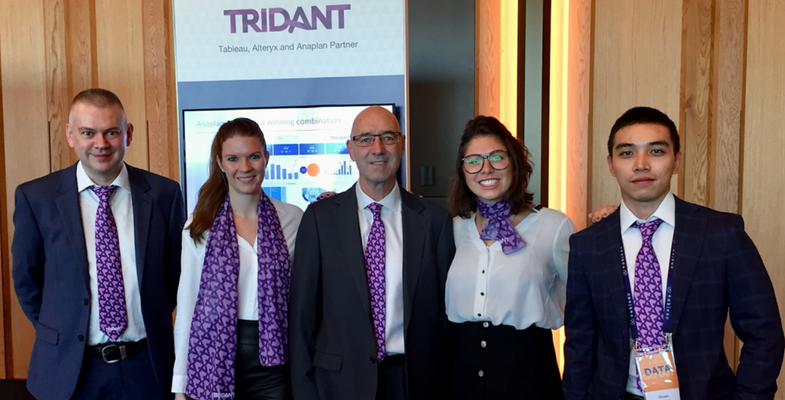
Recently the Tridant team attended the Tableau Data Day Out event in Sydney as well as spending the prior 2 days engaging with the Tableau team.
It has been a busy time at Tableau with them announcing the new role-based pricing, Tableau Prep, Tableau 2018.1, the beta for 2018.2 and the new Tableau starter kits.
Taking all of this into consideration, it was perfect timing for Tableau to hold the Data Day Out in Sydney and update all their clients and business partners. It was also fantastic to see Tableau sending Francois Ajenstat (Chief Product Officer) and Nate Vogel (Vice President, Worldwide Sales & Partner Readiness) to present at the events. Both Francois and Nate were engaging presenters and happy to talk to every Tableau customer present on the day.
The Data Day Out was attended by over 1000 people and the venue was packed in every session on the day. Tridant had a booth there and were happy that so many people enquired about how Tableau and Anaplan work together.
One of the biggest announcements which was also covered extensively on the day was Tableau Prep. Previously called Maestro before release, Tableau Prep is designed to help everyone cleanse, shape and blend their data before visualising it in Tableau. It’s an impressive 1st release for Prep and you can expect a monthly update to the product as the capabilities ramp up. Prep is designed on the same principals as Tableau Desktop with everything being instant feedback on your data. As well as providing a workflow of your data changes, you can also see immediate relationships and data quality with a drag/drop interface. Being a Mac user, I love the fact that I can install Prep and use it natively. Prep is a separate license key to Desktop, but any Desktop user can download and use Prep today. However, by 2020, you will need to ensure that you have moved across to the subscription-based pricing model to continue to have Prep. Of course, many people were wondering how that leaves Tableau/Alteryx - since so many companies use the combination. At Tridant, we can see the complimentary aspects of both Prep and Alteryx. If there are 10 users of Tableau in your organisation, and maybe 2 of them need to do the heavy lifting, predictive and data science work and the other 8 users would suffice on Prep.
Tableau is looking to ensure that it is easy to buy and easy to scale the product. Not everyone uses data in the same way, so a license model should reflect that. Also, Tableau wants to move away from server-based pricing which limits deployments when people are concerned about adding extra CPU in blocks of 8. New customers can adopt the new licensing straight away and the simplicity is in the fact that you don’t worry about server licensing.
So, there are now 3 license types, Tableau creator, Tableau Explorer and Tableau Viewer.
Tableau Creator is the power license for the full analytics capabilities of Tableau. This license gets Tableau Desktop, Tableau Prep and access to Tableau Server/Online. The important thing is that Creator license allows the user to connect to any datasource and publish.
Tableau Explorer license is the differentiator to the Microsoft Power BI licensing model. Explorer empowers the less technical allowing them to easily work in a governed self-service analytics environment. Users can’t create new datasources but it has full web edit capabilities plus alerts and subscription control for themselves and others.
Tableau Viewer is the cheapest license allowing organisations to scale deployments of Tableau. Viewers can view and filter existing dashboards either on web or mobile devices while also receiving alerts and subscriptions.
A neat thing people sometimes miss is that a Tableau administrator can be defined as a Creator or an Explorer.
There is a conversion process for existing Tableau customers to move to this model. If you are considering growing your Tableau usage base then it is a great opportunity to reach out and discuss how that conversion can work best for you over the next 4 years.
This is a massive release for Tableau and it is available right now. For an overview of the new features, please head to: https://www.tableau.com/2018-1-features.
The biggest feature is how well supported the end-to-end web authoring experience is. You can now almost do everything in web that you can do on desktop. This removes the need for organisations to be dependent on rolling out Desktop to power users. When combined with the new role-based pricing, it also opens up the ability to scale your users and server easily.
Tableau is now releasing each quarter and so 2018.2 is not that far away. If you want to keep up with the latest information on the new capabilities coming, then please review: https://www.tableau.com/products/coming-soon. Probably the most exciting feature is the Dashboard Extensions. We saw one very exciting extension that could take your dashboard and translate it into rich text based narrative. The feature to tag people in comments is also going to open up a lot more communication with Tableau server.
Currently available in the online server and shortly available more widely, the Tableau Start Dashboards are a great way to get an immediate Tableau set of Dashboards and Visualisations on the most popular cloud platforms. Dashboard Starters are pre-built dashboards that are designed based on best practices and populated with your own data. They get you up and running quickly to immediately find answers in your data. Customise and bring in data from other sources to continue your analysis and explore further. Currently available are Starter Dashboards for Salesforce, Eloqua, Marketo, and ServiceNow. Typically, these web applications have complicated data schemas but now Tableau customers can begin their analysis without having to understand which tables and fields to use.
If you would like to learn more about any of the above and perhaps benefit form a demonstration, then please contact us at info@tridant.com.
Copyright © Tridant Pty Ltd.